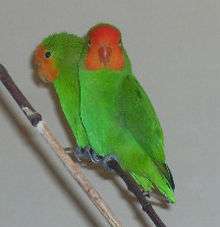Red-headed lovebird
| Red-headed lovebird | |
|---|---|
 | |
| Male (foreground) and female | |
| Scientific classification | |
| Kingdom: | Animalia |
| Phylum: | Chordata |
| Class: | Aves |
| Order: | Psittaciformes |
| Superfamily: | Psittacoidea |
| Family: | Psittaculidae |
| Subfamily: | Agapornithinae |
| Genus: | Agapornis |
| Species: | A. pullarius |
| Binomial name | |
| Agapornis pullarius (Linnaeus, 1758) | |
The red-headed lovebird (Agapornis pullarius) also known as the red-faced lovebird is a member of the genus Agapornis, a group commonly known as lovebirds. Like other lovebirds it is native to Africa.
Description
The red-headed lovebird is a 15 cm (6 inches) long, mostly green parrot. It has a well demarcated red area on its head extending from the top of the beak, over the forehead to mid-crown, and extending to the left and right up to the eyelid margins. It has grey feet. The underside of the wings is a lighter green. The female has orange head colouring, which is less well demarcated than the male's red head. The adult male has a red beak while the female's is a paler red.[2]
Distribution and habitat
It is native to a wide range in Africa including Angola, Burundi, Cameroon, Chad, Democratic Republic of the Congo, Equatorial Guinea, Ethiopia, Gabon, Ghana, Guinea, Kenya, Mali, Niger, Nigeria, Rwanda, Sierra Leone, South Sudan, Tanzania, Togo, and Uganda. In addition, it is an introduced species in Liberia.[1]
Breeding
It makes its nest in a termites nest usually in a tree or sometimes on the ground. To make a nest the female digs a tunnel up to a length of 30 cm (12 in) in the termites nest in a colony with other lovebirds.[2]
Aviculture
It is difficult to breed in captivity because it has to burrow to make its nest and the nest chamber needs to be heated to about 27 °C (81 °F); however, they can be induced to burrow into cork to build a nest. It is a very nervous species.[2]
References
- 1 2 BirdLife International (2012). "Agapornis pullarius". IUCN Red List of Threatened Species. Version 2013.2. International Union for Conservation of Nature. Retrieved 26 November 2013.
- 1 2 3 Le Breton, Kenny. Lovebirds...getting started. USA: T.F.H. Publications. pp. 85–88. ISBN 0-86622-411-4.
External links
- "Species factsheet: Agapornis pullarius". BirdLife International (2008). Retrieved 9 July 2008.
- Pullaria.info
